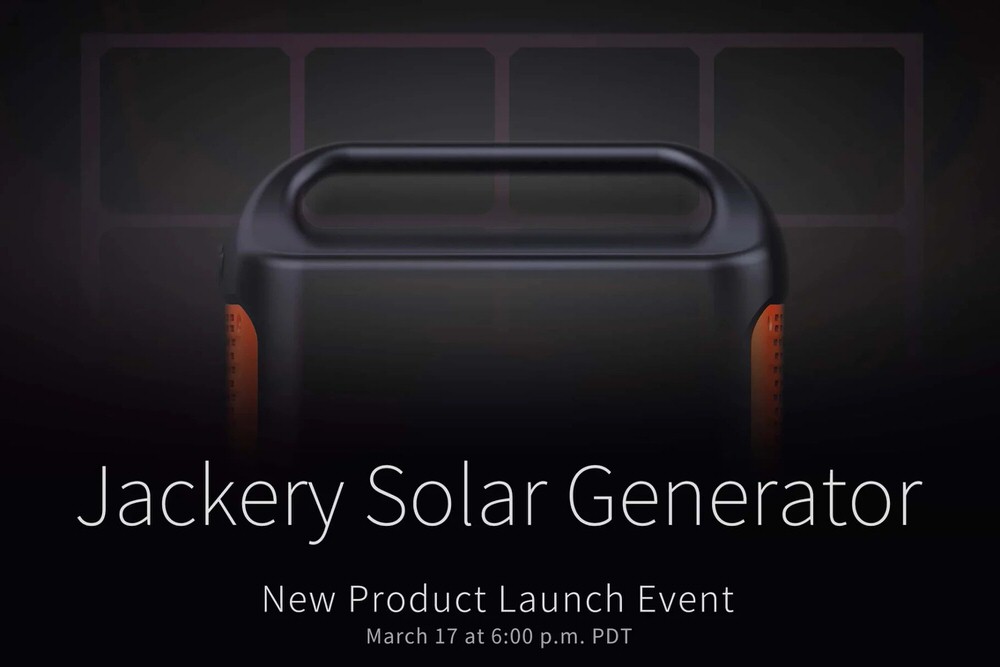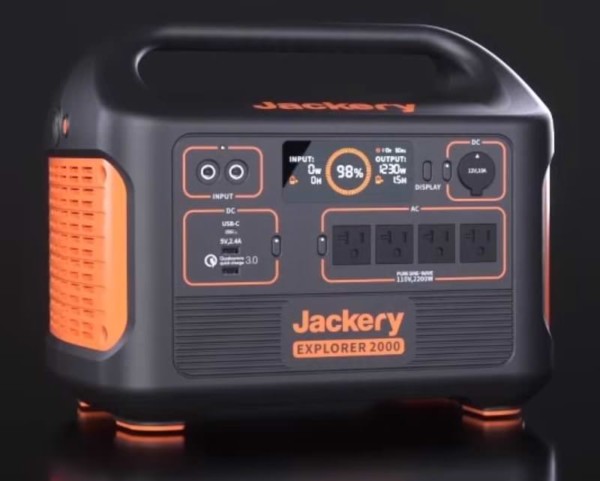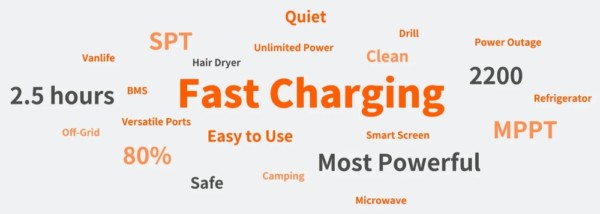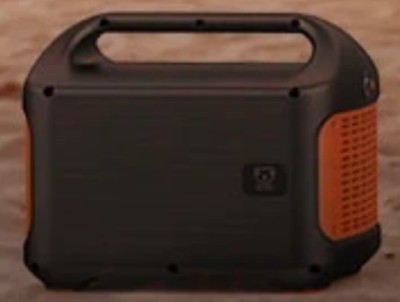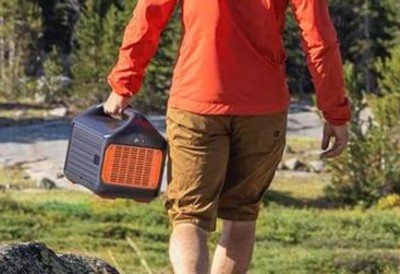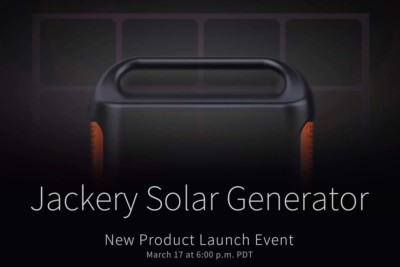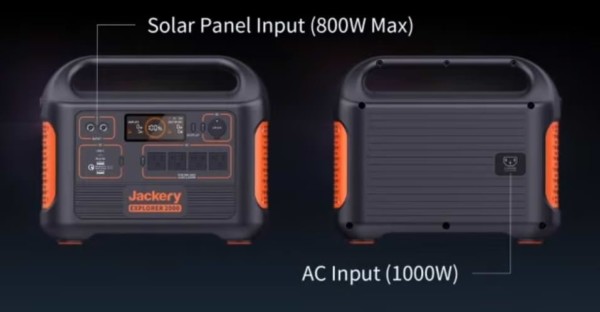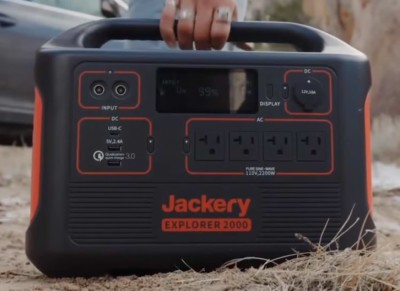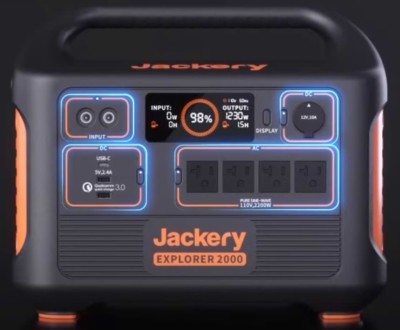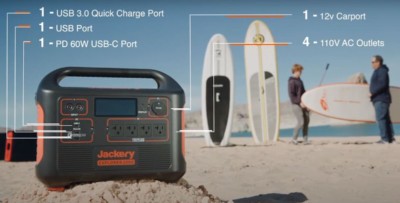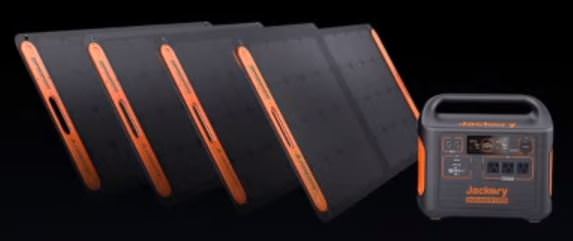Contents
Jackery Day 2021
Every 3rd Wednesday of March, Jackery holds its “Jackery Day” where new products are announced. This year, that date falls on March 17, 2021. [LIVE UPDATES: See here]
What can we anticipate? The company has teased an expected launch of its largest power station/solar generator yet, the Explorer 1500. I first heard about it from a friend at CES 2019. Based on a teaser image showing “2200”, it may come with a peak/surge rating of 2,200W with an unknown, continuous output capacity… Or will it be a surprise reveal of a Jackery Explorer 2000 (with 2,200Wh capacity)?
For comparison, the Jackery Explorer 1000 came with a running 1,000W (2,000W peak and 1,002Wh capacity) and the Goal Zero Yeti 1500x with continuous 2,000W (3,500W peak and 1,516Wh capacity).
Battery storage capacity is measured in Wh (Watt-hours) and power output is in W (Watts). A device’s power usage or a charging source’s output is rated in Watts (Amps x Voltage). See one of my battery power station reviews to learn more about Watts, Watt-hours, Continuous/Running and Peak/Surge outputs, and how to perform various calculations.
Expected Product Launches
Jackery Explorer 1500
Features we could expect from the Jackery Explorer 1500 are:
- Battery capacity: 1,500 Wh (approximate)
- Cost: $1,500. Jackery usually provides special, time-limited, launch pricing
- Pure Sine Wave AC Inverter to allow sensitive electronics to be used
- Continuous output: 1,200W (guesstimate)
- Peak output: 2,200W (guesstimate based on one of Jackery’s teaser images showing “2200”)
- The “2200” number may also refer to a surprise reveal for a Jackery Explorer 2000 (with 2,200 Wh capacity)
- Fast-charge capability
- Teaser image showing “80%” and “2.5 hours” could indicate the new Explorer being able to charge to 80% in that amount of time
- “80%” charge
- 80% of Explorer 1500 = 1,200Wh
- 80% of Explorer 2000 (2,200Wh assumption) = 1,760 Wh
- “2.5 hours” = Wh / Input Wattage (or) Input Wattage = Wh / 2.5 hours
- Explorer 1500 = 1,200 Wh / 2.5 hours = 480W input
- Explorer 2000 = 1,760 Wh / 2.5 hours = 704W input
- New Explorer may accept solar panels and/or AC brick charging at a rate of:
- 480W for the Explorer 1500
- 704W for the Explorer 2000
- This puts it in a competitive position with the Goal Zero Yeti 1500x that can accept a maximum of 600W
- MPPT charging controller built-in for more efficient solar charging
- Weight: 36-40 lbs
- Jackery’s power stations are generally lighter than Goal Zero’s because less metal components are used
- Goal Zero Yeti 1500x is 45.64 lbs @ 15.3″ x 10.3″ x 10.4″
- Dimensions: 13.1″ L x 9.2″ W and more than 13″ height
- Top quality batteries from LG or BAK Battery, although the Explorer 300 used those by EVE Battery
- The importance of using Tier 1 batteries cannot be stressed enough for the safe operation of a power station
- Quality Battery Management System (BMS) to safely regulate the batteries within their designed specifications
- Built-in flashlight with SOS signaling function
- Same exterior design with fixed carry handle and its iconic black/orange color scheme
- Will likely not provide space to internally store cables and AC adapters in. Goal Zero Yeti 1500x does with its top compartment
In Jackery’s teaser images (above), there appears to be a mysterious, new port at the “New” Explorer’s back side.
Ports
- Input
- (1) 8mm (12-30V, max 8A) up to 200W
- (1) Anderson Power Pole (APP) for higher-input solar charging
- Output
- (3) AC with 3 prongs (120V)
- (1) Cigarette socket (12V, max 10A)
- (2) USB-A (5V, max 2.4A, max 12W) with QuickCharge 3.0
- (2) USB-C PD (Power Delivery) with 60W of input AND output (5-20V, max 3A)
- Jackery Explorer 1000 only provided a measly 18W
- Updated version of the Explorer 300 enabled this port to be simultaneously used with the 8mm input to provide faster, combined charging
Jackery SolarSaga 200W?
Looking at the teaser image, an Explorer appears to be backdropped by a solar panel, and so we may see a new SolarSaga announced at the event. Goal Zero offers a lightweight Nomad 200 solar panel, and one can only hope that Jackery will release a competing SolarSaga 200W! [LIVE UPDATES: See here]
Jackery Explorer 2000?
As I had previously noted, the “2200” number in Jackery’s teaser image is particularly interesting. Does it refer to 2,200 Watts or 2,200 Watt-hours? If the latter, then a surprise announcement may come for the Jackery Explorer 2000 power station! [LIVE UPDATES: See here]
Live Launch Event
Between 3/1 – 3/19/2021, Jackery is holding a contest to celebrate its upcoming 3/17/2021 @ 6pm PST launch. Prizes include:
- Grand prize: Jackery Solar Generator* 1500
- First prize: Jackery Explorer 1500
- Second prize: Jackery Solar Generator* 1000
- This likely will include the Explorer 1000 and SolarSaga 100 panel(s)
- Third prize: Jackery SolarSaga 60
- Consolation prize: $20 off coupon for all products sitewide
* The company designates its “Solar Generators” as Power Station + Solar Panel combos.
Live Updates
Here are the details from the live event:
- Jackery Explorer 2000 | Check on Amazon
- Price: $2,099 | Pre-order: 3/18/2021
- Battery capacity: 2,060Wh
- Weight: 43 lbs
- Output
- (4) AC outlets @ 110V
- Inverter – Continuous: 2,200W / Peak: 4,400W
- (1) USB 3.0 QuickCharge (18W max)
- (1) USB-A (BC 1.2)
- (1) USB-C PD 60W
- (1) 12V Car (120W max)
- (4) AC outlets @ 110V
-
- Input
- Front
- Solar: 800W from up to (4) 200W SolarSaga solar panels
- “Solarpeak” technology improves on MPPT Solar Charging controller with 30% conversion efficiency
- Goal Zero Yeti 1500x only accepts up to 600W from (4) Nomad 200W or Boulder solar panels
- Solar: 800W from up to (4) 200W SolarSaga solar panels
- Back
- AC: 1000W from a built-in AC charger, eliminating the power brick
- Front
- 2.5 hours to solar fast charge from 0% to 80%
- New controller screen
- Input
- Jackery Explorer 1500 | Check on Amazon
- Price: $1,599 | On sale 4/5/2021
- Jackery SolarSaga 200W | Check on Amazon
- Price: $599 | Pre-order: 3/18/2021
- Waterproof rating: IP67 – Functional in light rain
- Built-in kickstands
- Jackery Solar Generator 2000
- Price: $4,299 | Pre-order: 3/18/2021
- Explorer 2000 + (4) SolarSaga 200W kit
- Jackery Solar Generator 1500
- Price: $2,699 | On sale 4/5/2021
- Explorer 1500 + (4) SolarSaga 100W kit
Amazing, technological accomplishments there, Jackery!
Final Thoughts
Jackery had impressed me with its quality, affordable power stations and stellar customer service. Its Explorer 1000, Explorer 300, and SolarSaga 100 had been great products for the more budget conscious person looking for emergency power or those seeking to bring comfort to outdoor adventures. Their ecosystem of accessories and expansion options, however, is not as vast as that afforded by the leader of the industry — Goal Zero — and those searching for home integration or more durable products would be advised to look into that company’s offering instead, such as the excellent Yeti 1500x, efficient Nomad 200, and my portable favorite, the Yeti 500x. Ultimately, I recommend both companies’ products, and which one is the “better choice” for you always depends on what your needs and budget are.
You can watch the launch event live on Wednesday, March 17, 2021 at 6pm (California PST time) on its TikTok, Facebook, YouTube, and Instagram channels. Jackery informed me that the Explorer 1500 would be available for purchase starting March 18. Whether an Explorer 2000 power station and/or SolarSaga 200W solar panel will be making a surprise appearance will be exciting to watch!
Where To Buy
- Jackery Explorer: Battery power stations with solar charging capability
- Jackery SolarSaga: Solar panels
Related Posts
- Power Generators: Gas vs Propane vs Battery Station (and Solar)
- Reviews
- Goal Zero vs Jackery: Yeti 1000 Core vs 1000X vs Explorer 1000
- Goal Zero Yeti 1500x / 1000x / 500x
- Jackery Explorer 2000 Pro / 1000 / 300
- EcoFlow Delta Pro LiFePO4
- BigBlue Cellpowa500 LiFePO4
- Rockpals 500W / nrgGo 400
- Quick Look
Other Useful Topics
Power Stations Comparison
Here is a summary of various power stations from Goal Zero, EcoFlow, Jackery Explorer, and others.
| Product | YuenX Review | Battery Capacity | AC Power (Steady) | AC Power (Peak) | Max Input | MSRP | Expand- able | Solar Charge | WiFi, BT | Battery Vendor | Weight | Dimensions (inches) |
|---|---|---|---|---|---|---|---|---|---|---|---|---|
| Goal Zero Yeti 200x | No | 187Wh NMC | 120W | 200W | 120W | $299 | No | MPPT | No | LG | 5 lbs | 7.9 x 5.1 x 5.1 |
| Jackery Explorer 300 | Review | 293Wh NMC | 300W | 500W | 90W | $349 | No | MPPT | No | EVE | 7.1 lbs | 9.1 x 5.2 x 7.8 |
| Goal Zero Yeti 500x | Review | 505Wh NMC | 300W | 1,200W | 120W | $549 | No | MPPT | No | LG | 12.9 lbs | 7.5 x 11.3 x 5.8 |
| Jackery Explorer 500 | No | 518Wh NMC | 500W | 1,000W | 100W | $599 | No | MPPT | No | LG | 13.3 lbs | 11.8 x 7.6 x 9.2 |
| Bluetti EB70S | Review | 716Wh LiFePO4 | 800W | 1,400W | 200W | $599 | No | MPPT | No | N/A | 21.4 lbs | 12.6 x 8.5 x 8.7 |
| EcoFlow Delta 1000 | No | 1,008Wh NMC | 1,600W | 3,100W | 1,000W | $799 | No | MPPT | No | EcoFlow | 30.9 lbs | 15.7 x 8.3 x 10.6 |
| EcoFlow Delta 2 | Quick Look | 1,024Wh LiFePO4 | 1,800W | 2,700W | 1,200W | $999 | Yes. EB, EB | MPPT | Yes | EcoFlow | 27 lbs | 15.7 x 8.3 x 11 |
| Goal Zero Yeti 1000c | Review | 983Wh NMC | 1,200W | 2,400W | 300W | $999 | No | MPPT | No | LG | 31.7 lbs | 15.3 x 10.2 x 9.9 |
| Goal Zero Yeti 1000x | Review | 983Wh NMC | 1,500W | 3,000W | 600W | $1,299 | Yes. YL | MPPT | No | LG | 31.7 lbs | 15.3 x 10.2 x 9.9 |
| Jackery Explorer 1000 | Review | 1,002Wh NMC | 1,000W | 2,000W | 200W | $999 | No | MPPT | No | LG, BAK | 22 lbs | 13.1 x 9.2 x 11.1 |
| Jackery Explorer 1000 Pro | No | 1,002Wh NMC | 1,000W | 2,000W | 800W | $1,099 | No | MPPT | No | LG, BAK | 25.4 lbs | 13.4 x 10.3 x 10.1 |
| Goal Zero Yeti 1500x | Review | 1,516Wh NMC | 2,000W | 3,500W | 600W | $1,799 | Yes. YL | MPPT | WiFi, BT | LG | 45.6 lbs | 15.3 x 10.2 x 10.4 |
| Jackery Explorer 1500 | No | 1,534Wh NMC | 1,800W | 3,600W | 500W | $1,599 | No | MPPT | No | N/A | 35.3 lbs | 14 x 10.4 x 12.7 |
| Jackery Explorer 2000 Pro | Review | 2,160Wh NMC | 2,200W | 4,400W | 1,400W | $2,099 | No | MPPT | No | N/A | 43 lbs | 15.1 x 10.5 x 12.1 |
| Goal Zero Yeti 3000x | No | 3,032Wh NMC | 2,000W | 3,500W | 600W | $3,199 | Yes. YL | MPPT | WiFi, BT | LG | 69.8 lbs | 15.3 x 10.2 x 13.6 |
| EcoFlow Delta Pro | Review | 3,600Wh LiFePO4 | 3,600W | 7,200W | 1,800-6,500W | $3,699 | Yes. EB | MPPT | WiFi, BT | EcoFlow | 99 lbs | 25 x 11.2 x 16.4 |
| Goal Zero Yeti 6000x | No | 6,010Wh NMC | 2,000W | 3,500W | 600W | $4,999 | Yes. YL | MPPT | WiFi, BT | LG | 106 lbs | 15.3 x 10.1 x 17 |
Gas/Propane Generators vs Battery Power Stations
In July 2020, I wrote about this topic after many asked what their differences were. In short, gas/propane generators can run virtually forever but are loud, dirty, and potentially quite dangerous. Battery power stations, on the other hand, are more portable, silent, less volatile, and can be operated indoor, but depend on external power (like solar) to recharge. Where gas/propane are used to GENERATE electricity, batteries STORE them for later use. Personally, I am a fan of the latter because they are so easy to carry around and are safer to use.
Goal Zero, EcoFlow, Bluetti, and Jackery are the leading brands in battery power stations.
Battery Technology and Safety
Goal Zero debuted with Lead-Acid batteries that were bulky and heavy. Today’s devices use Lithium-ion — commonly Nickel Manganese Cobalt (NCM) or Lithium Iron Phosphate (LiFePO4 / LFP) chemistries — for more power in a smaller, lighter package. NMC, however, is more volatile than LiFePO4 and becomes riskier as more cells are packed together. Goal Zero and Jackery used NMC for some time whereas EcoFlow and Bluetti use LiFePO4. Jackery launched its first LiFePO4 model in mid-June 2023 and Goal Zero in October that year.
- How much energy a battery can store is measured in Wh (Watt-hours), and how much power is used or produced in W (Watts)
- The higher the Watt-hour (Wh) capacity rating, the more dangerous the battery could become if not handled right
The quality of the battery cells and the BMS (Battery Management System) are crucial for safety.
Cell Manufacturers
Battery cells made by LG and Sony are among the best in the hobbyist world as are Sanyo/Panasonic and Samsung. Jackery uses LG or BAK. During my years of research, I found that use of lower-quality batteries could pose a serious risk to life and property and should become a crucial part in deciding what to buy.
Safety
The second part in a battery’s safe operation depends heavily on the design and BMS (Battery Management System). Some BMS manufacturers, unfortunately, overstate their capabilities that could lead to catastrophic failure.
- Design should allow for proper, thermal cooling, use quality components, and obtain proper certifications
- Batteries made by known manufacturers are less likely to fail
- BMS should sufficiently restrict the battery from going past its capabilities

